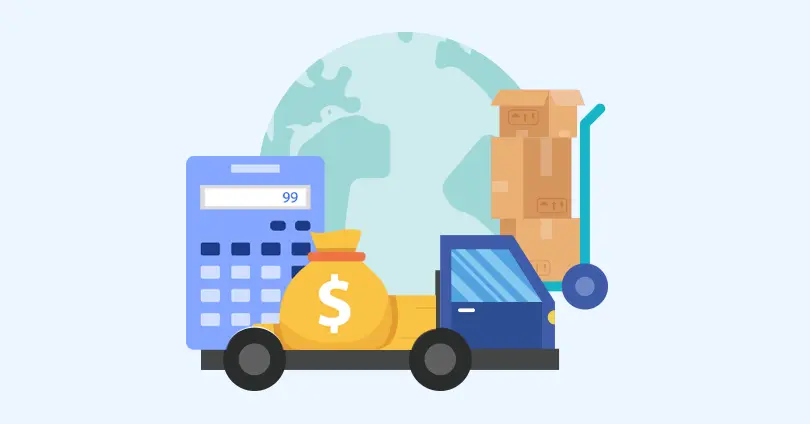In the fast-paced world of global shipping and logistics, businesses are constantly seeking ways to optimize their supply chains and cut costs. One crucial element that often determines a company's shipping expenses is the freight rate it pays. Freight rates can be highly variable, influenced by factors such as market demand, shipping routes, and the volume of goods being transported. Among the different types of freight rates, the Named Account Contract (NAC) rate stands out as a strategic solution for companies with large shipping volumes. But what exactly is a NAC rate, and how does it compare to other types of shipping rates? In this article, we will delve deep into the concept of NAC rates, their applications in various industries, and offer valuable tips on how businesses can effectively negotiate NAC rates to secure better deals.
What is a NAC Rate in Shipping?
NAC rate, or Named Account Contract rate, is a customized freight rate negotiated between a shipping company and a specific customer, typically based on the customer's shipping volume, routes, and long-term commitment. It often results in significant cost savings compared to other standard rates, such as spot or tariff rates.
NAC rates are not available to everyone. They are typically reserved for customers who have a long-term relationship with a shipping carrier and can commit to shipping a significant volume of goods over a set period. Because of this high level of commitment, the shipping carrier is willing to offer a lower rate than the one offered to smaller shippers or those who ship sporadically. The idea behind NAC rates is simple: in exchange for guaranteed business, the shipping carrier rewards the customer with a more competitive rate, leading to savings for the company.
Comparison Between NAC Rates and Other Shipping Rates
To fully understand the value of NAC rates, it’s important to compare them with other types of shipping rates. These include spot rates, tariff rates, and FAK rates. Each of these rates serves a different purpose and caters to different types of shippers.
Spot Rate
A spot rate is the price for shipping goods at a specific point in time, based on current market conditions. Spot rates are highly volatile and can fluctuate dramatically depending on supply and demand, seasonality, and external factors such as port congestion or geopolitical events. They are often used by businesses that ship infrequently or those that do not have long-term contracts with carriers.
Example: Imagine a small business that only ships goods occasionally. Without a long-term contract, they rely on spot rates. During peak holiday seasons, spot rates can spike, reaching as high as $1,300 per 20-foot container for shipments from Shanghai to Los Angeles. In contrast, a company with a NAC rate might only pay $950 for the same shipment, thanks to their negotiated agreement.
Comparison: Spot rates offer flexibility, as there is no long-term commitment required. However, they expose shippers to price volatility. NAC rates, on the other hand, offer stability and predictability, which is particularly valuable for companies with consistent shipping needs.
Tariff Rate
Tariff rates are the published shipping rates provided by carriers. These rates are standard across all customers, and they do not vary based on shipping volume or frequency. Tariff rates are often the starting point for negotiations, but they are generally higher than what can be achieved through NAC rates.
Example: A smaller manufacturer might pay the tariff rate of $1,100 per 20-foot container for shipping goods from Europe to the US. However, a company with a NAC agreement might only pay $950 for the same shipment.
Comparison: Tariff rates are typically higher than NAC rates because they do not account for customer-specific factors such as volume or long-term commitment. NAC rates are personalized and tailored to the needs of large-volume shippers, providing them with more competitive pricing.
FAK Rate (Freight All Kinds)
A FAK rate is a bulk rate that covers a wide variety of cargo types under a single pricing structure. FAK rates are often used by businesses that ship multiple types of goods but want a simple, uniform pricing system. These rates are typically lower than spot or tariff rates, but they may not offer the same level of customization as NAC rates.
Example: A logistics company may use a FAK rate to ship various products, such as electronics and clothing, under one flat rate of $1,050 per container, regardless of the specific type of cargo. However, a company with a NAC rate tailored specifically to its shipping needs might pay only $950.
Comparison: FAK rates are simpler and more standardized but lack the personalization and potential cost savings that NAC rates offer for high-volume shippers. NAC rates are customized to the specific shipping patterns and needs of individual businesses, often resulting in lower costs.
Application of NAC Rates in Different Industries
NAC rates are not one-size-fits-all. They are tailored to the specific needs of different industries, depending on the nature of the goods being shipped, the volume of shipments, and the shipping routes used. Here’s how NAC rates are applied in several key industries:
1. Retail and E-commerce
In the retail and e-commerce sectors, companies ship large volumes of goods, especially during peak shopping seasons such as Black Friday and the holiday season. E-commerce giants like Amazon and Walmart rely heavily on NAC rates to secure predictable and lower shipping costs for their massive and frequent shipments.
Example: A major e-commerce company negotiates a NAC rate for shipping electronics from China to the US. During peak times, when spot rates skyrocket, the company can still rely on its NAC rate, which offers a stable and lower price per container, ensuring that shipping costs remain manageable.
How NAC Helps: For retailers, NAC rates offer cost predictability and prevent sudden price spikes during peak seasons. They also ensure reliable capacity from carriers, which is crucial for timely deliveries.
2. Automotive Industry
The automotive industry operates on a just-in-time (JIT) manufacturing model, meaning that parts and components must arrive at assembly plants exactly when needed. Any delays in shipping can disrupt the entire production line, leading to costly downtime. NAC rates provide the stability and predictability needed to keep the supply chain running smoothly.
Example: A global car manufacturer ships parts from Japan to assembly plants in the US and Europe. By negotiating a NAC rate, the company secures lower shipping costs and ensures that parts are delivered on time, avoiding costly delays in production.
How NAC Helps: The automotive industry benefits from the cost stability and reliability that NAC rates provide. With long-term agreements in place, manufacturers can avoid the price volatility associated with spot rates and ensure that their supply chain remains uninterrupted.
3. Pharmaceutical Industry
Pharmaceutical companies often ship high-value, temperature-sensitive goods such as medications and vaccines. These shipments require specialized containers and timely delivery to ensure that the products arrive in optimal condition. For this reason, NAC rates are essential in the pharmaceutical industry, as they provide not only cost savings but also the assurance of reliable service.
Example: A pharmaceutical company negotiates a NAC rate for shipping vaccines from Europe to North America. This rate includes the use of temperature-controlled containers and guarantees priority handling, ensuring that the vaccines arrive on time and in perfect condition.
How NAC Helps: NAC rates provide pharmaceutical companies with the cost certainty and specialized services they need to safely transport sensitive goods. By securing a long-term agreement with a carrier, they can avoid the higher costs and uncertainties associated with spot rates.
4. Consumer Packaged Goods (CPG)
Companies in the consumer packaged goods (CPG) sector, such as those producing food, beverages, and household products, rely on frequent and consistent shipments to keep their supply chains moving. NAC rates are particularly valuable in this industry, where large volumes of goods are shipped regularly.
Example: A global food manufacturer negotiates a NAC rate for shipping perishable goods from South America to North America. This rate ensures that the company can ship large quantities of goods at a lower cost, even during peak agricultural seasons when shipping demand is high.
How NAC Helps: NAC rates allow CPG companies to control costs and avoid the price fluctuations that come with spot rates. This is especially important for perishable goods, where timely delivery is critical.
How to Negotiate NAC Rates in Shipping
Negotiating NAC rates requires a strategic approach. Carriers are more likely to offer favorable NAC rates to businesses that can demonstrate a consistent shipping volume and a long-term commitment. Here are some tips for negotiating the best NAC rates:
1. Analyze Your Shipping Data
Before entering into negotiations, it’s important to gather detailed information about your shipping needs. This includes data on your shipping volume, routes, and frequency of shipments. The more data you have, the stronger your negotiating position will be.
Example: A company that ships 1,000 containers annually from Asia to North America can use this volume as leverage to negotiate a lower NAC rate. By presenting this data to the carrier, the company can demonstrate its value as a customer.
2. Leverage Volume and Commitment
Carriers are more likely to offer lower NAC rates to customers who can commit to shipping a large volume of goods over a long period. If your business can guarantee a certain volume of shipments, you’ll have more negotiating power.
Example: A business that agrees to ship a minimum of 500 containers per year may be able to negotiate a discount of 10–15% compared to the standard rate.
3. Bundle Services for Better Terms
Carriers often offer a variety of services beyond just ocean freight, including warehousing, customs brokerage, and inland transportation. By bundling these services, you can negotiate better overall terms and lower your NAC rate.
Example: A company that uses the carrier’s warehousing and trucking services in addition to ocean freight may be able to secure a more favorable NAC rate as part of a comprehensive service agreement.
4. Explore Multiple Carriers
While building a strong relationship with one carrier can be beneficial, it’s always a good idea to get quotes from multiple carriers. This allows you to compare rates and services, ensuring that you’re getting the best deal.
Example: If one carrier offers a NAC rate of $1,000 per container, but another offers $950, you can use this information to negotiate further discounts with your preferred carrier.
5. Build Long-Term Relationships
Carriers value long-term, reliable customers. By building a strong relationship with your carrier, you increase your chances of securing better NAC rates in future negotiations.
Example: Regularly review the carrier’s performance and maintain open lines of communication. If the carrier knows that you are a loyal customer, they may be more willing to offer lower rates during your next negotiation.
6. Offer Favorable Payment Terms
Carriers appreciate prompt payment, and offering faster payment terms can sometimes lead to lower rates. If you can commit to paying invoices within a shorter time frame, such as 15 days instead of the typical 30, you may be able to negotiate a better NAC rate.
Summary
In conclusion, NAC rates provide businesses with a valuable tool for controlling shipping costs, particularly for companies that ship large volumes of goods on a regular basis. By securing a NAC rate, businesses can avoid the volatility of spot rates and the higher costs of tariff rates. NAC rates are widely used in industries such as retail, automotive, pharmaceuticals, and consumer packaged goods, where predictable shipping costs are essential for maintaining a smooth supply chain.
To successfully negotiate a NAC rate, businesses should analyze their shipping data, leverage their volume, explore multiple carriers, and consider bundling services for better terms. By building strong, long-term relationships with carriers, businesses can secure favorable NAC rates that lead to significant cost savings and improved supply chain efficiency.
In the competitive world of global logistics, mastering NAC rate negotiation is a key strategy for staying ahead.






